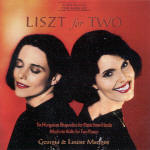Franz Liszt orchestrated six of his solo piano Hungarian Rhapsodies, then made piano duet editions of the orchestral versions. In other words, the duet textures mirror the orchestral layouts and are not to be taken as an easier way to get around the solo versions’ technical difficulties. Georgia and Louise Mangos may not match the visceral power and tonal variety you get from an orchestra at full throttle, but they come close enough to satisfy the pickiest piano transcription fan. Scales and filigree proudly glitter in Nos. 2 and 4 (respectively adapted from the solo 12th and 2nd Rhapsodies), and the F minor and E-flat major Rhapsodies (the solo 14th and 9th) nearly burst at the seams with powerful chord playing that resonates rather than bangs. However, the Third Rhapsody’s churning opening section moves faster than it can comfortably dance.
As an arrangement in and of itself, I’m more convinced by Liszt’s duet transformation of his First Mephisto Waltz. Here, though, the Mangos sisters fail to maintain their initial basic tempo in the opening section, and they lay heavily on the downbeats throughout the sublime D-flat major episode. Still, we must admire the siblings’ marvelously synchronized ensemble work. After the symphonic poems and now the Hungarian Rhapsodies, perhaps the Mangos will take on Liszt’s opera paraphrase duets next. Stay tuned . . .
































